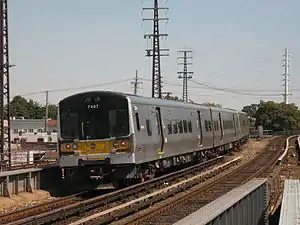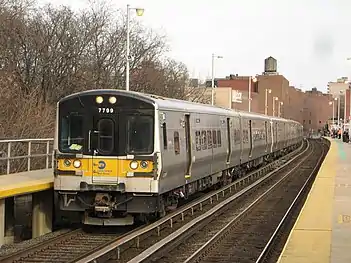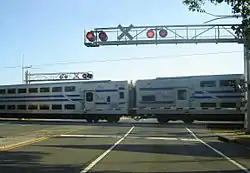Babylon Branch
The Babylon Branch is a rail service operated by the Long Island Rail Road in the U.S. state of New York. The term refers to the trains serving Montauk Branch stations from Valley Stream east to Babylon; in other words, the Babylon Branch is a rail service rather than an actual track. The electrification of the Montauk Branch ends east of the Babylon station, so the Babylon Branch is mostly served by electric trains.
| Babylon Branch | ||||||||||||||||||||||||||||||||||||||||||||||||||||||||||||||||||||||||||||||||||||||||||||||||||||||||||||||||||||||||||||||||||||||||||||||||||||||||||||||||||||||||||||||||||||||||||||||||||||||||||||||||||||||||||||||||||||||||||||||||||||||||||||||||||||||||||||||||||||||||||||||
|---|---|---|---|---|---|---|---|---|---|---|---|---|---|---|---|---|---|---|---|---|---|---|---|---|---|---|---|---|---|---|---|---|---|---|---|---|---|---|---|---|---|---|---|---|---|---|---|---|---|---|---|---|---|---|---|---|---|---|---|---|---|---|---|---|---|---|---|---|---|---|---|---|---|---|---|---|---|---|---|---|---|---|---|---|---|---|---|---|---|---|---|---|---|---|---|---|---|---|---|---|---|---|---|---|---|---|---|---|---|---|---|---|---|---|---|---|---|---|---|---|---|---|---|---|---|---|---|---|---|---|---|---|---|---|---|---|---|---|---|---|---|---|---|---|---|---|---|---|---|---|---|---|---|---|---|---|---|---|---|---|---|---|---|---|---|---|---|---|---|---|---|---|---|---|---|---|---|---|---|---|---|---|---|---|---|---|---|---|---|---|---|---|---|---|---|---|---|---|---|---|---|---|---|---|---|---|---|---|---|---|---|---|---|---|---|---|---|---|---|---|---|---|---|---|---|---|---|---|---|---|---|---|---|---|---|---|---|---|---|---|---|---|---|---|---|---|---|---|---|---|---|---|---|---|---|---|---|---|---|---|---|---|---|---|---|---|---|---|---|---|---|---|---|---|---|---|---|---|---|---|---|---|---|---|---|---|
 Babylon Branch train #108 departs the Lynbrook Station, bound for Babylon station. | ||||||||||||||||||||||||||||||||||||||||||||||||||||||||||||||||||||||||||||||||||||||||||||||||||||||||||||||||||||||||||||||||||||||||||||||||||||||||||||||||||||||||||||||||||||||||||||||||||||||||||||||||||||||||||||||||||||||||||||||||||||||||||||||||||||||||||||||||||||||||||||||
| Overview | ||||||||||||||||||||||||||||||||||||||||||||||||||||||||||||||||||||||||||||||||||||||||||||||||||||||||||||||||||||||||||||||||||||||||||||||||||||||||||||||||||||||||||||||||||||||||||||||||||||||||||||||||||||||||||||||||||||||||||||||||||||||||||||||||||||||||||||||||||||||||||||||
| Status | Operational | |||||||||||||||||||||||||||||||||||||||||||||||||||||||||||||||||||||||||||||||||||||||||||||||||||||||||||||||||||||||||||||||||||||||||||||||||||||||||||||||||||||||||||||||||||||||||||||||||||||||||||||||||||||||||||||||||||||||||||||||||||||||||||||||||||||||||||||||||||||||||||||
| Owner | Long Island Rail Road | |||||||||||||||||||||||||||||||||||||||||||||||||||||||||||||||||||||||||||||||||||||||||||||||||||||||||||||||||||||||||||||||||||||||||||||||||||||||||||||||||||||||||||||||||||||||||||||||||||||||||||||||||||||||||||||||||||||||||||||||||||||||||||||||||||||||||||||||||||||||||||||
| Locale | Nassau and Suffolk County, New York, USA | |||||||||||||||||||||||||||||||||||||||||||||||||||||||||||||||||||||||||||||||||||||||||||||||||||||||||||||||||||||||||||||||||||||||||||||||||||||||||||||||||||||||||||||||||||||||||||||||||||||||||||||||||||||||||||||||||||||||||||||||||||||||||||||||||||||||||||||||||||||||||||||
| Termini | Lynbrook Babylon | |||||||||||||||||||||||||||||||||||||||||||||||||||||||||||||||||||||||||||||||||||||||||||||||||||||||||||||||||||||||||||||||||||||||||||||||||||||||||||||||||||||||||||||||||||||||||||||||||||||||||||||||||||||||||||||||||||||||||||||||||||||||||||||||||||||||||||||||||||||||||||||
| Stations | 14 | |||||||||||||||||||||||||||||||||||||||||||||||||||||||||||||||||||||||||||||||||||||||||||||||||||||||||||||||||||||||||||||||||||||||||||||||||||||||||||||||||||||||||||||||||||||||||||||||||||||||||||||||||||||||||||||||||||||||||||||||||||||||||||||||||||||||||||||||||||||||||||||
| Service | ||||||||||||||||||||||||||||||||||||||||||||||||||||||||||||||||||||||||||||||||||||||||||||||||||||||||||||||||||||||||||||||||||||||||||||||||||||||||||||||||||||||||||||||||||||||||||||||||||||||||||||||||||||||||||||||||||||||||||||||||||||||||||||||||||||||||||||||||||||||||||||||
| Type | Commuter rail | |||||||||||||||||||||||||||||||||||||||||||||||||||||||||||||||||||||||||||||||||||||||||||||||||||||||||||||||||||||||||||||||||||||||||||||||||||||||||||||||||||||||||||||||||||||||||||||||||||||||||||||||||||||||||||||||||||||||||||||||||||||||||||||||||||||||||||||||||||||||||||||
| System | Long Island Rail Road | |||||||||||||||||||||||||||||||||||||||||||||||||||||||||||||||||||||||||||||||||||||||||||||||||||||||||||||||||||||||||||||||||||||||||||||||||||||||||||||||||||||||||||||||||||||||||||||||||||||||||||||||||||||||||||||||||||||||||||||||||||||||||||||||||||||||||||||||||||||||||||||
| Services | ||||||||||||||||||||||||||||||||||||||||||||||||||||||||||||||||||||||||||||||||||||||||||||||||||||||||||||||||||||||||||||||||||||||||||||||||||||||||||||||||||||||||||||||||||||||||||||||||||||||||||||||||||||||||||||||||||||||||||||||||||||||||||||||||||||||||||||||||||||||||||||||
| Operator(s) | Metropolitan Transportation Authority | |||||||||||||||||||||||||||||||||||||||||||||||||||||||||||||||||||||||||||||||||||||||||||||||||||||||||||||||||||||||||||||||||||||||||||||||||||||||||||||||||||||||||||||||||||||||||||||||||||||||||||||||||||||||||||||||||||||||||||||||||||||||||||||||||||||||||||||||||||||||||||||
| History | ||||||||||||||||||||||||||||||||||||||||||||||||||||||||||||||||||||||||||||||||||||||||||||||||||||||||||||||||||||||||||||||||||||||||||||||||||||||||||||||||||||||||||||||||||||||||||||||||||||||||||||||||||||||||||||||||||||||||||||||||||||||||||||||||||||||||||||||||||||||||||||||
| Opened | 1867 (as part of the Southern Railroad of Long Island) | |||||||||||||||||||||||||||||||||||||||||||||||||||||||||||||||||||||||||||||||||||||||||||||||||||||||||||||||||||||||||||||||||||||||||||||||||||||||||||||||||||||||||||||||||||||||||||||||||||||||||||||||||||||||||||||||||||||||||||||||||||||||||||||||||||||||||||||||||||||||||||||
| Technical | ||||||||||||||||||||||||||||||||||||||||||||||||||||||||||||||||||||||||||||||||||||||||||||||||||||||||||||||||||||||||||||||||||||||||||||||||||||||||||||||||||||||||||||||||||||||||||||||||||||||||||||||||||||||||||||||||||||||||||||||||||||||||||||||||||||||||||||||||||||||||||||||
| Track gauge | 4 ft 8 1⁄2 in (1,435 mm) standard gauge | |||||||||||||||||||||||||||||||||||||||||||||||||||||||||||||||||||||||||||||||||||||||||||||||||||||||||||||||||||||||||||||||||||||||||||||||||||||||||||||||||||||||||||||||||||||||||||||||||||||||||||||||||||||||||||||||||||||||||||||||||||||||||||||||||||||||||||||||||||||||||||||
| Electrification | 750 V (DC) third rail | |||||||||||||||||||||||||||||||||||||||||||||||||||||||||||||||||||||||||||||||||||||||||||||||||||||||||||||||||||||||||||||||||||||||||||||||||||||||||||||||||||||||||||||||||||||||||||||||||||||||||||||||||||||||||||||||||||||||||||||||||||||||||||||||||||||||||||||||||||||||||||||
| ||||||||||||||||||||||||||||||||||||||||||||||||||||||||||||||||||||||||||||||||||||||||||||||||||||||||||||||||||||||||||||||||||||||||||||||||||||||||||||||||||||||||||||||||||||||||||||||||||||||||||||||||||||||||||||||||||||||||||||||||||||||||||||||||||||||||||||||||||||||||||||||
The west end of the "Babylon Branch" is the junction between the West Hempstead Branch and Montauk Branch (Valley Interlocking); St. Albans, the only stop on the Montauk Branch west of Valley Stream, is shown in the West Hempstead Branch despite being served by Babylon Branch trains on weekends. Some Montauk Branch trains operate nonstop through Babylon Branch stations until reaching Babylon, though others use the Central Branch between Belmont Junction west of Babylon station and a junction at Beth Interlocking on the Main Line southeast of Bethpage Station, running to New York City via the Main Line.[1][2] On weekends, Babylon Branch trains typically stop at Forest Hills and Kew Gardens in the eastbound direction as opposed to other Main Line trains that serve other branches.[2]
The Babylon Branch portion of the Montauk Branch is completely grade separated with bridges over all intersecting roadways. New York State Route 231 and the Meadowbrook Parkway are the two exceptions to this; the tracks pass under these roadways.
History
The South Side Railroad of Long Island in the 1860s built what was to become the Montauk Branch of the Long Island Rail Road. The Babylon Branch as a separate operational entity began as the electrification of the Montauk Branch between Valley Stream and Babylon on May 20, 1925. Eventually, this would also include the former "Springfield Branch" which the Montauk Branch was relocated to northeast of Springfield Junction. The tracks were elevated from ground-level between 1950 and 1980. Elevation of the line sparked grass-roots efforts to preserve the previous versions of Wantagh and Lindendurst Stations, the former of which resulted in the creation of the Wantagh Railroad Museum. The last station to be elevated on the branch was Massapequa Park on December 13, 1980.[3]

On December 30, 1968, the first revenue train of M1 cars departed Babylon for Penn Station. In anticipation, all stations that were still at grade level had their platforms converted from low-level to high-level (an increase of 4 feet) from late-1967 to late-1968 in time for when the fleet went into service. Stations that were still at-grade at the time were Lindenhurst, Copiague, Amityville, Massapequa Park, Bellmore, and Merrick. The former three's grade separation projects had just gotten underway a few months prior, while Massapequa Park was still at-grade and the latter two were being prepared for their projects. All stations that had been elevated were equipped with single high-level island platforms, except for Babylon, which had two platforms. The call for high-level platforms was due to the M1 lacking steps that the fleet they were replacing had, and to make travel times quicker by several minutes.
Work on grade separation began in 1970. The stretch of track between Amityville and Lindenhurst was grade-separated, with new high-level platforms on elevated viaducts, on August 7th, 1973.[4] At the same time, the stretch of track through Bellmore and Merrick was grade-separated, which was completed on June 28th, 1975. Finally, beginning in 1977 the stretch of track through Massapequa Park was elevated and opened on December 13th, 1980.
Since the 1990s, many station houses along the branch have been rebuilt, including the entire platforms at Seaford from July 2008 to July 2009, Massapequa from late 2013 to mid 2015, and Wantagh from late 2016 to late 2018. Additionally, from July 2007 to April 10, 2011 the signals, switches, and gantries were replaced between Wantagh and Amityville, with color light signals replacing the old position-light signals installed during the elevation of that section in 1973, and work is underway is well into the closing stages of a pocket track East of the Massapequa station that will run in between the two running tracks, this was to be completed by Spring 2016, but is currently on hiatus. Plans for the future include the modernization of Babylon Interlocking, viaduct track replacement at certain stations, replacement of platforms, escalators, and elevators at Babylon. There is also the possibility of Massapequa Park, Amityville, Copiague, and Lindenhurst receiving elevators to make them ADA accessible. Those 4 stations are the only ones on the branch that are not ADA accessible.
Stations
West of Lynbrook, most trips go on to terminate at Penn Station, with some trips ending at Jamaica or Hunterspoint Avenue.[2]
| Zone[5] | Location | Station | Miles (km) from NYP[6] |
Date opened |
Date closed |
Connections and notes |
|---|---|---|---|---|---|---|
| 3 | St. Albans, Queens | St. Albans (limited service) |
11.8 (19.0) | 1898[7] | New York City Bus: Q4 | |
| 4 | Lynbrook | Lynbrook (limited service)[2] |
17.7 (28.5) | 1867[8] | Long Island Rail Road: Long Beach Branch Nassau Inter-County Express: n4, n25, n31, n32 Originally named Pearsall's Corners, then Pearsall's | |
| 7 | Rockville Centre | Rockville Centre |
19.3 (31.1) | 1867 | Nassau Inter-County Express: n15, n16, Mercy Medical Shuttle | |
| Baldwin | Baldwin |
21.2 (34.1) | 1867 | Nassau Inter-County Express: n35 Originally named Baldwinsville,[9] then Baldwins | ||
| Freeport | Freeport |
22.7 (36.5) | 1867 | Nassau Inter-County Express: n4, n19, n40, n41, n43, n88 | ||
| Merrick | Merrick |
24.1 (38.8) | 1867 | |||
| Bellmore | Bellmore |
25.6 (41.2) | 1869 | |||
| Wantagh | Wantagh |
25.9 (41.7) | 1867 | Originally named Ridgewood | ||
| Seaford | Seaford |
27.7 (44.6) | 1899 | Nassau Inter-County Express: n54 | ||
| Massapequa | Massapequa |
28.7 (46.2) | 1867 | Nassau Inter-County Express: n54, n55, n80 Originally named South Oyster Bay | ||
| Massapequa Park | Massapequa Park | 29.5 (47.5) | 1933 | Nassau Inter-County Express: n54, n55, n80 | ||
| East Massapequa | Unqua | 1880 | 1881 | |||
| 9 | Amityville | Amityville | 30.6 (49.2) | 1868 | Suffolk County Transit: 1A, S1, S20, S33 | |
| Copiague | Copiague | 32.4 (52.1) | 1902 | Suffolk County Transit: S20, S31 | ||
| Belmont Junction | 1875 | 1876 | ||||
| Lindenhurst | Lindenhurst | 33.7 (54.2) | 1867 | Suffolk County Transit: S20 Originally named Wellwood, then Breslau | ||
| Babylon | Babylon |
36.6 (58.9) | 1867[8] | Long Island Rail Road: Montauk Branch Suffolk County Transit: S20, S23, S25, S27, S29, S40, S42, S47 Originally named Seaside[8] |
References
- MTA LIRR - LIRR Map
- LIRR Babylon Branch Timetable
- LIRR Grade Crossing Elimination Projects (TraisnAreFun.com)
- Burks, Edward C. (August 7, 1973). "L.I.R.R. to offer Smoother Ride Today". The New York Times. Retrieved January 2, 2019.
- "New Fares — Effective April 21, 2019". Metropolitan Transportation Authority. Retrieved April 27, 2020.
- Station pages linked from MTA LIRR - Stations, accessed April 24, 2020.
- Long Island Railroad Station History (TrainsAreFun.com)
- Vincent F. Seyfried, The Long Island Rail Road: A Comprehensive History, Part One: South Side R.R. of L.I., © 1961
- Baldwinsville Station (Arrt's Arrchives)
External links
![]() Media related to Babylon Branch (Long Island Rail Road) at Wikimedia Commons
Media related to Babylon Branch (Long Island Rail Road) at Wikimedia Commons


